A few clips of Jimmy Staridas playing with Spiros Grammenos during our time in Athens.
[kaltura-widget wid=”210gmhnufc” width=”600″ height=”515″ addpermission=”0″ editpermission=”0″ /]
A few clips of Jimmy Staridas playing with Spiros Grammenos during our time in Athens.
[kaltura-widget wid=”210gmhnufc” width=”600″ height=”515″ addpermission=”0″ editpermission=”0″ /]
We have received a few comments that there are not enough pictures of Sam on the blog. Well, here are a couple pictures of the master photographer at work. While I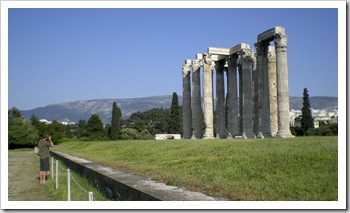 stick with my cute red point and shoot camera, Sam is kneeling on the ground, crouching into precarious spots and climbing over walls and fences that he probably shouldn’t. I have been given the opportunity, however, to snap a few of what ET calls ‘angles’ when I happen to see a good shot which is usually accompanied with a few lessons on using the polarizer and setting the lens aperture properly. So (Mom) as I learn more, you will start to see more pictures of The Photographer but I thought you would enjoy these red poppies and the Temple of Zeus for a start.
stick with my cute red point and shoot camera, Sam is kneeling on the ground, crouching into precarious spots and climbing over walls and fences that he probably shouldn’t. I have been given the opportunity, however, to snap a few of what ET calls ‘angles’ when I happen to see a good shot which is usually accompanied with a few lessons on using the polarizer and setting the lens aperture properly. So (Mom) as I learn more, you will start to see more pictures of The Photographer but I thought you would enjoy these red poppies and the Temple of Zeus for a start.
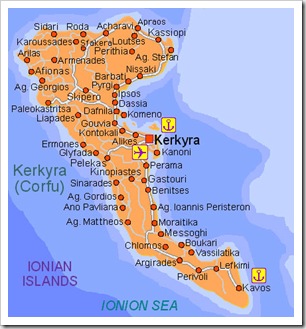
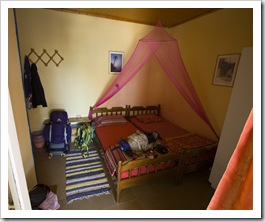 First off, a little explanation of the post’s title: most tourists know the island of Kerkyra by its tourist name, Corfu, which was instantiated because English-speaking tourists had trouble with the traditional Greek name of Kerkyra. So if you’ve heard of Corfu before, it’s actual name is Kerkyra, so that’s what we’ll use here… We traveled to Kerkyra from Santorini to explore one of the Ionian islands off Greece’s west coast. We also wanted to see where my mum spent her summers teaching water-skiing and romping about in a bikini when she was in her twenties, I’ve heard a lot of stories about her time on Kerkyra so we thought a visit was in order. Kerkyra’s landscape is markedly different to that of the volcanic Cyclades islands (Santorini is one of the Cyclades): the black rocks and barren landscapes are replaced by lush greenery and rolling hills on
First off, a little explanation of the post’s title: most tourists know the island of Kerkyra by its tourist name, Corfu, which was instantiated because English-speaking tourists had trouble with the traditional Greek name of Kerkyra. So if you’ve heard of Corfu before, it’s actual name is Kerkyra, so that’s what we’ll use here… We traveled to Kerkyra from Santorini to explore one of the Ionian islands off Greece’s west coast. We also wanted to see where my mum spent her summers teaching water-skiing and romping about in a bikini when she was in her twenties, I’ve heard a lot of stories about her time on Kerkyra so we thought a visit was in order. Kerkyra’s landscape is markedly different to that of the volcanic Cyclades islands (Santorini is one of the Cyclades): the black rocks and barren landscapes are replaced by lush greenery and rolling hills on 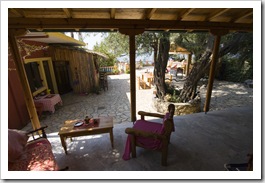 Kerkyra, its limestone base makes for excellent coves and beautiful sandy beaches all around the island. We left Santorini in the midst of horizontal rain and gale-force winds (we were a little concerned that our plane wasn’t going to take off!) to arrive in Kerkyra under clear blue skies and 32°C (90°F) weather. We stayed at the Rolling Stone above Pelekas Beach (N39°35.191’ E19°49.175’) on the island’s
Kerkyra, its limestone base makes for excellent coves and beautiful sandy beaches all around the island. We left Santorini in the midst of horizontal rain and gale-force winds (we were a little concerned that our plane wasn’t going to take off!) to arrive in Kerkyra under clear blue skies and 32°C (90°F) weather. We stayed at the Rolling Stone above Pelekas Beach (N39°35.191’ E19°49.175’) on the island’s 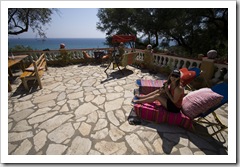
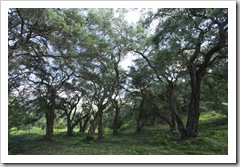 west coast, a small hippie-inspired hotel of six rooms and a couple of apartments run by German-born Ira and her friendly Greek ever-so-stylish husband Themis. Themis picked us up from the airport for a hair-rising ride across the 17 kilometer stretch between Kerkyra Town and Pelekas dressed in his pointed cowboy boots, tight jeans and a stylin’ t-shirt that would make Todd Baldwin jealous. The Rolling Stone was great (if you don’t mind a bit of late night music in the courtyard now and then), we were even invited to eat dinner with Themis and Ira’s family on our first night, a
west coast, a small hippie-inspired hotel of six rooms and a couple of apartments run by German-born Ira and her friendly Greek ever-so-stylish husband Themis. Themis picked us up from the airport for a hair-rising ride across the 17 kilometer stretch between Kerkyra Town and Pelekas dressed in his pointed cowboy boots, tight jeans and a stylin’ t-shirt that would make Todd Baldwin jealous. The Rolling Stone was great (if you don’t mind a bit of late night music in the courtyard now and then), we were even invited to eat dinner with Themis and Ira’s family on our first night, a 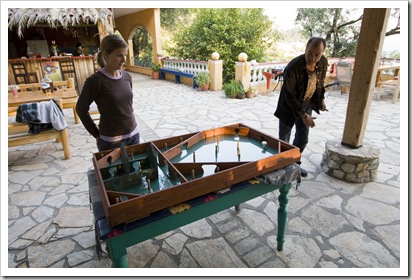 scrumptious Kerkyran specialty of stewed veal and pasta. Lisa fell in love with Rolling Stone’s seven month old pup named Maggie, a couple of times Maggie would be waiting outside our bedroom door in the morning as she quickly learned we were always good for attention. Kerkyra is only about 150 kilometers from the eastern coast of Italy, it’s quite a big island, during our four and a
scrumptious Kerkyran specialty of stewed veal and pasta. Lisa fell in love with Rolling Stone’s seven month old pup named Maggie, a couple of times Maggie would be waiting outside our bedroom door in the morning as she quickly learned we were always good for attention. Kerkyra is only about 150 kilometers from the eastern coast of Italy, it’s quite a big island, during our four and a 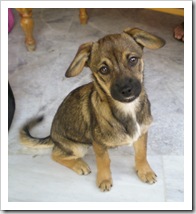 half days there we only managed to explore the top half of its 58 kilometer span. The island is absolutely covered with olive trees, 99.9% of the harvest is devoted to making olive oil due to the small size of the fruit produced by the particular species of trees on the island. The olive groves on Kerkyra are the tallest olive trees either of us has ever seen, they tower 30 or 40 feet tall with trunks that resemble the oaks in California. The harvest is performed by laying black synthetic netting over the ground throughout the entire grove and then catching the fruit as it falls (we couldn’t quite gather if they shake the trees or wait for the olives to drop naturally). The groves were really a sight to behold, everyone we met who was a local seemed to have a grove somewhere on the island.
half days there we only managed to explore the top half of its 58 kilometer span. The island is absolutely covered with olive trees, 99.9% of the harvest is devoted to making olive oil due to the small size of the fruit produced by the particular species of trees on the island. The olive groves on Kerkyra are the tallest olive trees either of us has ever seen, they tower 30 or 40 feet tall with trunks that resemble the oaks in California. The harvest is performed by laying black synthetic netting over the ground throughout the entire grove and then catching the fruit as it falls (we couldn’t quite gather if they shake the trees or wait for the olives to drop naturally). The groves were really a sight to behold, everyone we met who was a local seemed to have a grove somewhere on the island.
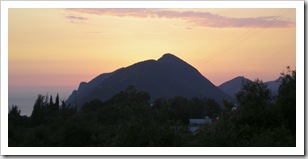
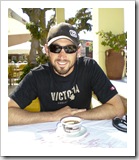
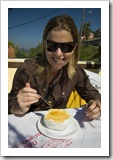
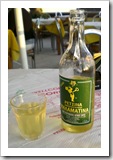 The island’s west coast was the most picturesque area we explored: beautiful rolling green hills dotted with white-walled, red-roofed villages and limestone cliffs that make for fantastic coves and beautiful beaches. Pelekas, where we stayed, is in the center of the west coast and is one of the best beaches we found during our time on Kerkyra. The beach was about 100 meters down the hill
The island’s west coast was the most picturesque area we explored: beautiful rolling green hills dotted with white-walled, red-roofed villages and limestone cliffs that make for fantastic coves and beautiful beaches. Pelekas, where we stayed, is in the center of the west coast and is one of the best beaches we found during our time on Kerkyra. The beach was about 100 meters down the hill 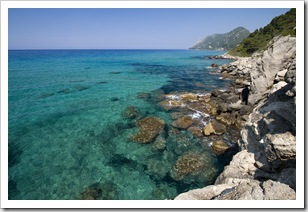
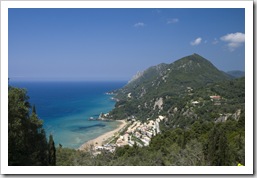 from the Rolling Stone, white sand stretching for a kilometer or so hemmed in by limestone ridges at either end (typical of all the beaches on Kerkyra). The water was warmer than Santorini but still a little chilly, the clarity and turquoise color was second to none though. The town of Pelekas was a (very) steep walk up the winding road from the beach, about 45 minutes each way. We ate in Pelekas twice at Alexandro’s Pizza, probably the best pizza either one of us has ever tasted, the second time we dined we ordered a whole pizza each and prepped by fasting from breakfast to make room! We also made the drive up to Paleokastritsa (pictured to the left below) (N39°40.369’ E19°42.062’), one of Kerkyra’s most famed coastal areas, to take a look at the amazing array of coves and beaches dotted along the nearby coast. These days the area is littered with beachfront restaurants and bars as well
from the Rolling Stone, white sand stretching for a kilometer or so hemmed in by limestone ridges at either end (typical of all the beaches on Kerkyra). The water was warmer than Santorini but still a little chilly, the clarity and turquoise color was second to none though. The town of Pelekas was a (very) steep walk up the winding road from the beach, about 45 minutes each way. We ate in Pelekas twice at Alexandro’s Pizza, probably the best pizza either one of us has ever tasted, the second time we dined we ordered a whole pizza each and prepped by fasting from breakfast to make room! We also made the drive up to Paleokastritsa (pictured to the left below) (N39°40.369’ E19°42.062’), one of Kerkyra’s most famed coastal areas, to take a look at the amazing array of coves and beaches dotted along the nearby coast. These days the area is littered with beachfront restaurants and bars as well 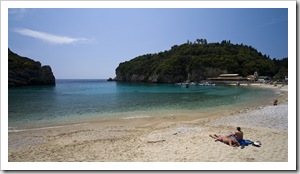
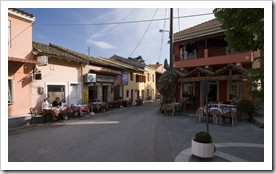 as a myriad of hotels catering to the western European package tourists that flock there during the peak of summer. The natural beauty of the place is still in tact though, we made a short walk north of the main strip to find a small cove to ourselves where we spent the afternoon on the beach and snorkeling in the crystal clear Ionian Sea. While on our way home from Paleokastritsa we took a bit of detour and found a gem hidden away in the west coast’s hills, the town of Doukades (pictured here to the left) is a sleepy mountain village with a couple of small tavernas spread around the center of town. We enjoyed a great dinner, scrumptious home-made dolmades
as a myriad of hotels catering to the western European package tourists that flock there during the peak of summer. The natural beauty of the place is still in tact though, we made a short walk north of the main strip to find a small cove to ourselves where we spent the afternoon on the beach and snorkeling in the crystal clear Ionian Sea. While on our way home from Paleokastritsa we took a bit of detour and found a gem hidden away in the west coast’s hills, the town of Doukades (pictured here to the left) is a sleepy mountain village with a couple of small tavernas spread around the center of town. We enjoyed a great dinner, scrumptious home-made dolmades 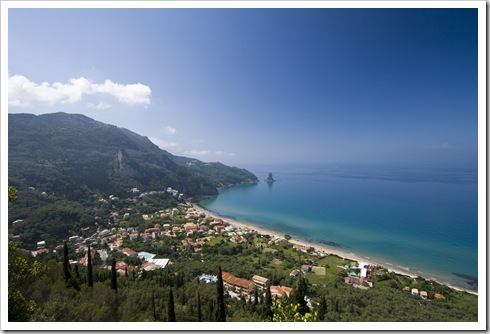 and our first time sampling oven-baked feta. On our second to last day we made a
and our first time sampling oven-baked feta. On our second to last day we made a 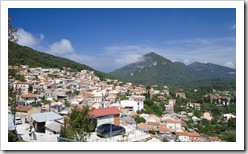 trip south down the west coast from Pelekas, we passed another famous bathing spot on the way, Agios Gordis, recognizable by the small rock island of Tholeto at the southern end of the beach (pictured here to the left). We were searching for more beaches and coves along the coast but didn’t find anything as spectacular as
trip south down the west coast from Pelekas, we passed another famous bathing spot on the way, Agios Gordis, recognizable by the small rock island of Tholeto at the southern end of the beach (pictured here to the left). We were searching for more beaches and coves along the coast but didn’t find anything as spectacular as 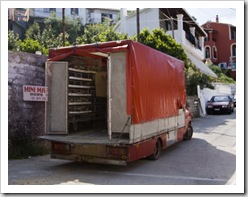 Paleokastritsa or any stretches of sand as nice as Glyfada or Pelekas (where we were staying). Fun to make the drive though, and the quaint mountain village of Agios Mattheos was interesting to drive through. A bit of an eye-opener we encountered a number of times on Kerkyra, something we didn’t see anywhere else in Greece or Turkey, were mobile chicken markets: small trucks with their cargo sections turned into chicken hatcheries! They’d drive around the island with loudspeakers attached to the roof hooting and hollering about their chickens for sale. We had to pull over to let the one pictured here pass us on one of the skinny streets of Agios Mattheos.
Paleokastritsa or any stretches of sand as nice as Glyfada or Pelekas (where we were staying). Fun to make the drive though, and the quaint mountain village of Agios Mattheos was interesting to drive through. A bit of an eye-opener we encountered a number of times on Kerkyra, something we didn’t see anywhere else in Greece or Turkey, were mobile chicken markets: small trucks with their cargo sections turned into chicken hatcheries! They’d drive around the island with loudspeakers attached to the roof hooting and hollering about their chickens for sale. We had to pull over to let the one pictured here pass us on one of the skinny streets of Agios Mattheos.
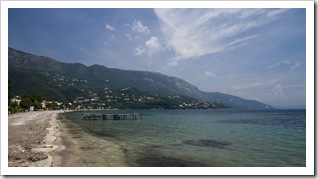
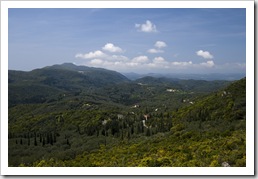 We made the trek to the island’s north coast a couple of times during our stay on Kerkyra: once to visit Sidari and Roda Beach, the other to hike part of the Corfu Trail from Strinilas to Moni Pantokratora (Kerkyra’s tallest peak). Our trip to Sidari and Roda was a little disappointing, the once beautiful beaches and picturesque seaside towns have been turned into masses of English pubs and gaudy souvenir shops, there wasn’t much Greek to see at either spot. Mum had told me stories of her painting the Roda Beach Hotel in her bikini, at that time the first hotel in Roda, as well as spending time sunbathing on the beautiful beaches around Sidari.
We made the trek to the island’s north coast a couple of times during our stay on Kerkyra: once to visit Sidari and Roda Beach, the other to hike part of the Corfu Trail from Strinilas to Moni Pantokratora (Kerkyra’s tallest peak). Our trip to Sidari and Roda was a little disappointing, the once beautiful beaches and picturesque seaside towns have been turned into masses of English pubs and gaudy souvenir shops, there wasn’t much Greek to see at either spot. Mum had told me stories of her painting the Roda Beach Hotel in her bikini, at that time the first hotel in Roda, as well as spending time sunbathing on the beautiful beaches around Sidari. 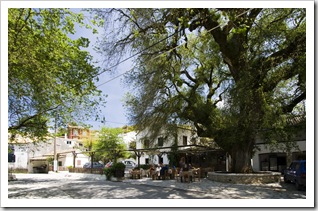 But now, just like Bodrum, both locales have been overrun with package tourists from western Europe and the towns’ charm has mostly disappeared. We didn’t even take any photos, and on this trip that’s a stretch! Not to be deterred, we talked to some locals about the Corfu Trail, a hiking trail covering some 227 kilometers around the island, and ventured back to the island’s north on another day to walk a section of it up to the peak of Moni Pantokratora (N39°44.027’ E19°50.853’). The road to Strinilas (N39°44.656’ E19°50.226’), the starting point of our hike, follows the east coast of Kerkyra until Pirgi, at which point it veers off the main drag and winds up into the mountains. The road after Pirgi has bends that, in the words of one guide book,
But now, just like Bodrum, both locales have been overrun with package tourists from western Europe and the towns’ charm has mostly disappeared. We didn’t even take any photos, and on this trip that’s a stretch! Not to be deterred, we talked to some locals about the Corfu Trail, a hiking trail covering some 227 kilometers around the island, and ventured back to the island’s north on another day to walk a section of it up to the peak of Moni Pantokratora (N39°44.027’ E19°50.853’). The road to Strinilas (N39°44.656’ E19°50.226’), the starting point of our hike, follows the east coast of Kerkyra until Pirgi, at which point it veers off the main drag and winds up into the mountains. The road after Pirgi has bends that, in the words of one guide book, 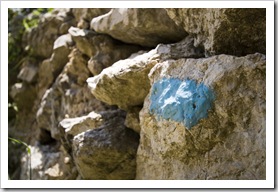 make the Monaco Grand Prix look like a walk in the park! We do agree, it’s probably one of the windiest roads either of us has ever been on, Lisa had that pale ‘I’m going to be sick’ look plastered across her face a number of times. But the drive was worth it, as we reached the highlands we were greeted with
make the Monaco Grand Prix look like a walk in the park! We do agree, it’s probably one of the windiest roads either of us has ever been on, Lisa had that pale ‘I’m going to be sick’ look plastered across her face a number of times. But the drive was worth it, as we reached the highlands we were greeted with 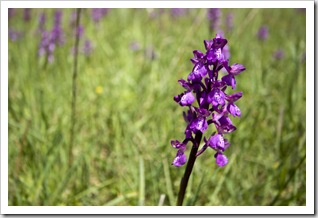 fields of beautiful wildflowers and views across the entire northern end of the island. We found a taverna on Strinilas’ central square and talked to the waiter about the Corfu Trail; turned out that the trail passed through the taverna’s courtyard so after lunch we made the roughly 12 kilometer loop to the peak of Moni Pantokratora through some beautiful farmland and very picturesque fields of highland wildflowers. At times we were following the blue markers, others we had to use the surrounding hills as a guide and wing it to the next blue marker, at which point one of us would yell “blue paint” with some relief. Similar to our trip on a portion of the Lycian Way in Turkey the blue markers of the Corfu Trail were lifesavers. We walked back along the road to the east of our route up and were rewarded with some fantastic views of the island’s east coast. For our drive back that day we took the long way around the northern and eastern edges of the island, taking in the beautiful beach at Almiros, the town of Kassiopi and finally stopping for a beer at a waterfront taverna in Nissaki.
fields of beautiful wildflowers and views across the entire northern end of the island. We found a taverna on Strinilas’ central square and talked to the waiter about the Corfu Trail; turned out that the trail passed through the taverna’s courtyard so after lunch we made the roughly 12 kilometer loop to the peak of Moni Pantokratora through some beautiful farmland and very picturesque fields of highland wildflowers. At times we were following the blue markers, others we had to use the surrounding hills as a guide and wing it to the next blue marker, at which point one of us would yell “blue paint” with some relief. Similar to our trip on a portion of the Lycian Way in Turkey the blue markers of the Corfu Trail were lifesavers. We walked back along the road to the east of our route up and were rewarded with some fantastic views of the island’s east coast. For our drive back that day we took the long way around the northern and eastern edges of the island, taking in the beautiful beach at Almiros, the town of Kassiopi and finally stopping for a beer at a waterfront taverna in Nissaki.
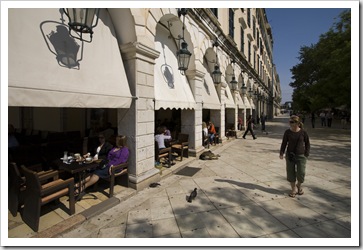
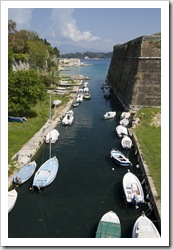 Kerkyra Town (Corfu Town), the main village on the island, was a real highlight for us. The bustling central location of the island is in the middle of the east coast just next to the airport and is where most of the Greek inhabitants of Kerkyra reside. Unlike Santorini, which effectively becomes a ghost town during the winter months, the majority of the Greek population live on Kerkyra year round. Kerkyra Town is about 17 kilometers from where we stayed on Pelekas, a quick drive across the island in our little rental car. The roads were extremely confusing, I don’t think we took the same route twice during our five days on the island, once ending up having a heated finger-pointing match as we tried to figure out how we found ourselves on the east coast heading up to the mountains when we were supposed to be heading back to Pelekas! Kerkyra Town is a mix of old and new: Palaio Frourio (the old Venetian fortress) and Italian-inspired architecture of the old town intermingled with up-market cafes and modern
Kerkyra Town (Corfu Town), the main village on the island, was a real highlight for us. The bustling central location of the island is in the middle of the east coast just next to the airport and is where most of the Greek inhabitants of Kerkyra reside. Unlike Santorini, which effectively becomes a ghost town during the winter months, the majority of the Greek population live on Kerkyra year round. Kerkyra Town is about 17 kilometers from where we stayed on Pelekas, a quick drive across the island in our little rental car. The roads were extremely confusing, I don’t think we took the same route twice during our five days on the island, once ending up having a heated finger-pointing match as we tried to figure out how we found ourselves on the east coast heading up to the mountains when we were supposed to be heading back to Pelekas! Kerkyra Town is a mix of old and new: Palaio Frourio (the old Venetian fortress) and Italian-inspired architecture of the old town intermingled with up-market cafes and modern 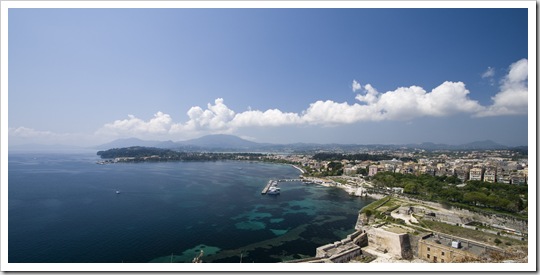 apartment buildings to the town’s west. We read about the plethora of cafes lining the Liston and quickly found that it’s quite an institution
apartment buildings to the town’s west. We read about the plethora of cafes lining the Liston and quickly found that it’s quite an institution 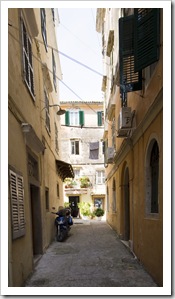 amongst the Kerkyrans to enjoy a coffee for an hour or two at one of the strip’s establishments. We did so ourselves on two mornings, enjoying our Greek coffees which, in Kerkyra at least, are usually served with a croissant or biscotti. The cafes are so popular in Kerkyra’s old town that we actually had trouble (a lot of trouble) finding any form of restaurant or eatery that served food during the morning! The Liston was a fantastic people watching spot, all of the cafes serve alcohol in the evenings and we sat there for quite some time late one night just watching the people go by and adrenaline-fueled kids racing their bicycles through the crowds. The narrow walkways between the Spianada and more modern quarter of Kerkyra Town were great for a walk, we could have been somewhere in Italy instead of an island off Greece. Kerkyra was another great stop along our way, thanks Mum for the idea and also Vassilis for some local knowledge.
amongst the Kerkyrans to enjoy a coffee for an hour or two at one of the strip’s establishments. We did so ourselves on two mornings, enjoying our Greek coffees which, in Kerkyra at least, are usually served with a croissant or biscotti. The cafes are so popular in Kerkyra’s old town that we actually had trouble (a lot of trouble) finding any form of restaurant or eatery that served food during the morning! The Liston was a fantastic people watching spot, all of the cafes serve alcohol in the evenings and we sat there for quite some time late one night just watching the people go by and adrenaline-fueled kids racing their bicycles through the crowds. The narrow walkways between the Spianada and more modern quarter of Kerkyra Town were great for a walk, we could have been somewhere in Italy instead of an island off Greece. Kerkyra was another great stop along our way, thanks Mum for the idea and also Vassilis for some local knowledge.
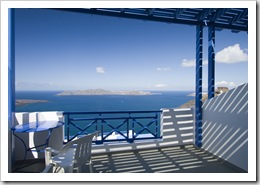
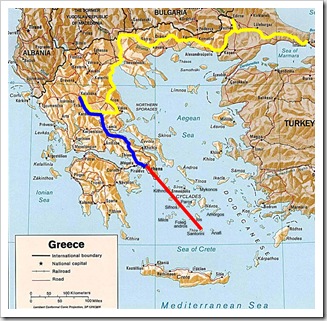 Santorini is the southernmost of the Cyclades islands in the Aegean Sea, sitting just north of Crete smack in the middle of Greece and Turkey. The island is the caldera of an active volcano, it’s well known for its sugar-cubed houses perched precariously on the cliff edge with spectacular views of the Aegean and surrounding islands. We spent almost a week on Santorini, making the trip for Tariq and Andrea’s wedding, which was on May 2 at Tholos Resort (N36°26.024’ E25°25.253’) in the town of Imerovigli. They couldn’t have ordered better weather, the ceremony was held on the edge of the caldera with a beautiful sunset as the backdrop. It was great to be able to share their special day with them, as well as catch up with a few mates from Saint Marks who made the trip from locations including New York, Glasgow, Brisbane, Perth and Adelaide. A lot of fun getting us all together for the occasion (thanks Tariq!). The wedding party stayed at Tholos Resort, we stayed one town south of Imerovigli
Santorini is the southernmost of the Cyclades islands in the Aegean Sea, sitting just north of Crete smack in the middle of Greece and Turkey. The island is the caldera of an active volcano, it’s well known for its sugar-cubed houses perched precariously on the cliff edge with spectacular views of the Aegean and surrounding islands. We spent almost a week on Santorini, making the trip for Tariq and Andrea’s wedding, which was on May 2 at Tholos Resort (N36°26.024’ E25°25.253’) in the town of Imerovigli. They couldn’t have ordered better weather, the ceremony was held on the edge of the caldera with a beautiful sunset as the backdrop. It was great to be able to share their special day with them, as well as catch up with a few mates from Saint Marks who made the trip from locations including New York, Glasgow, Brisbane, Perth and Adelaide. A lot of fun getting us all together for the occasion (thanks Tariq!). The wedding party stayed at Tholos Resort, we stayed one town south of Imerovigli 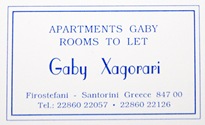 in the village of Firostefani at Gaby’s Apartments (N36°25.386’ E25°25.696’) run by Katerina and her sister Maria (not sure where Gaby comes into it). The location was fabulous, we were right on the caldera edge with 1000 feet of cliffs directly below us, the sunsets and views were exceptional. The apartment was great, extremely clean (it’s something we notice after trudging through Turkey and northern Greece!) and a fantastic location only 400 meters walk from the main town of Fira. The picture above to the left was the view from our deck, can you ask for more?!
in the village of Firostefani at Gaby’s Apartments (N36°25.386’ E25°25.696’) run by Katerina and her sister Maria (not sure where Gaby comes into it). The location was fabulous, we were right on the caldera edge with 1000 feet of cliffs directly below us, the sunsets and views were exceptional. The apartment was great, extremely clean (it’s something we notice after trudging through Turkey and northern Greece!) and a fantastic location only 400 meters walk from the main town of Fira. The picture above to the left was the view from our deck, can you ask for more?!
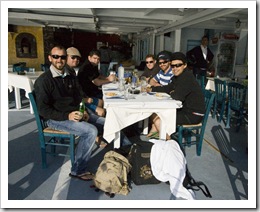
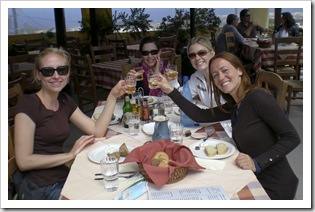 We arrived in Santorini on Wednesday, April 29 and the following day set out for the hens and bucks nights in preparation for the wedding on Saturday. The hens spent the afternoon riding horses on Kamari Beach on the island’s east coast while the bucks took a boat trip from Ammoudi at the island’s northern tip to explore the caldera and surrounding islands. Both Tanja (the maid of honor) and ET (the best man) put a lot of effort into the day, I know both Lisa and I had a fantastic time and appreciate their work.
We arrived in Santorini on Wednesday, April 29 and the following day set out for the hens and bucks nights in preparation for the wedding on Saturday. The hens spent the afternoon riding horses on Kamari Beach on the island’s east coast while the bucks took a boat trip from Ammoudi at the island’s northern tip to explore the caldera and surrounding islands. Both Tanja (the maid of honor) and ET (the best man) put a lot of effort into the day, I know both Lisa and I had a fantastic time and appreciate their work.
The hens didn’t have a lot of experience riding horses, only Lisa had ever ridden a horse before so it was quite an ordeal. They were dropped by a taxi near Kamari Beach and then walked down a dirt road to find the stables. A number of the girls were a little timid to start, Sally ended up the with stable owner’s horse and Andrea (the bride) had a horse with an absolute mind of its own. Dinner at Nikki’s in Fira was thoroughly enjoyed by all (I heard about the grilled squid at Nikki’s for a number of days afterwards) followed by dancing at Tropicana and onto Murphy’s Bar (where the bucks ran into them).
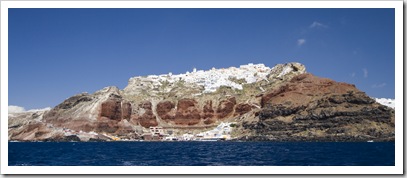 The bucks were picked up in Imerovigli around 1:30PM and taken to the port of Ammoudi at the northern end of the island. Our faithful captain George, one of the only people I met who stays on Santorini through winter and also one of the only people I talked to who has more than a single generation of family history on Santorini,
The bucks were picked up in Imerovigli around 1:30PM and taken to the port of Ammoudi at the northern end of the island. Our faithful captain George, one of the only people I met who stays on Santorini through winter and also one of the only people I talked to who has more than a single generation of family history on Santorini, 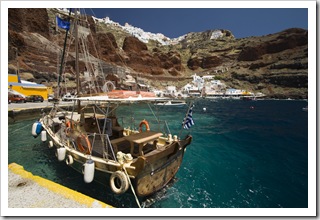 showed us a great afternoon. We cruised past Manolas, the main town on the neighboring island of Thirasia, and then to the hot springs (N36°24.058’ E25°23.331’) on Nea Kameni, which is an island in the center of the volcano. The hot springs were unlike any I have seen before: instead of being isolated pools they were simply a cove in the ocean that was far warmer than the surrounding water. But we knew we were near hot springs as the typical overpowering smell of sulfur was ever-present. We cruised around to the eastern side of Nea Kameni for a swim, witnessed a near-drowning of Squino and, if I couldn’t swim as well as I can, a possible fist fight in the water, followed by a slow motor back to Ammoudi for dinner. (An afternoon of beers is always better with a Squino incident of some sort.) Ammoudi is evidently the best place on the island to view the sunset as it’s the last place on Santorini with a view of the sun before it disappears over the horizon. We couldn’t have asked for a better sunset during dinner (a couple of shots below).
showed us a great afternoon. We cruised past Manolas, the main town on the neighboring island of Thirasia, and then to the hot springs (N36°24.058’ E25°23.331’) on Nea Kameni, which is an island in the center of the volcano. The hot springs were unlike any I have seen before: instead of being isolated pools they were simply a cove in the ocean that was far warmer than the surrounding water. But we knew we were near hot springs as the typical overpowering smell of sulfur was ever-present. We cruised around to the eastern side of Nea Kameni for a swim, witnessed a near-drowning of Squino and, if I couldn’t swim as well as I can, a possible fist fight in the water, followed by a slow motor back to Ammoudi for dinner. (An afternoon of beers is always better with a Squino incident of some sort.) Ammoudi is evidently the best place on the island to view the sunset as it’s the last place on Santorini with a view of the sun before it disappears over the horizon. We couldn’t have asked for a better sunset during dinner (a couple of shots below).
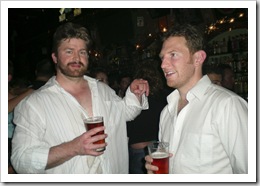
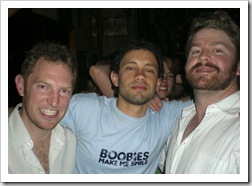 We all ended up at Murphy’s Bar at some point in the night (I nabbed Lisa’s camera to get these photos) and then moved on to the Koo Club before grabbing a late night gyros (yiros). The Koo Club is quite the place, a waiter we talked to later in the week said that during the peak of summer they will cram in 3000+ people! It has huge outdoor seating areas and multiple floors inside. At some point during the night ET thought the masses might like to see him undress, the beginning of which is pictured below. We ended up drinking the night away in the bars of Fira, I walked home around 3:00AM; Squino still can’t remember how he got home or what happened to the €100 he had in his pocket at 1:30AM!
We all ended up at Murphy’s Bar at some point in the night (I nabbed Lisa’s camera to get these photos) and then moved on to the Koo Club before grabbing a late night gyros (yiros). The Koo Club is quite the place, a waiter we talked to later in the week said that during the peak of summer they will cram in 3000+ people! It has huge outdoor seating areas and multiple floors inside. At some point during the night ET thought the masses might like to see him undress, the beginning of which is pictured below. We ended up drinking the night away in the bars of Fira, I walked home around 3:00AM; Squino still can’t remember how he got home or what happened to the €100 he had in his pocket at 1:30AM!
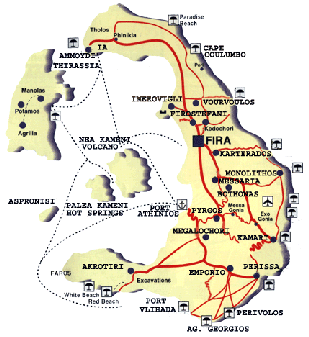
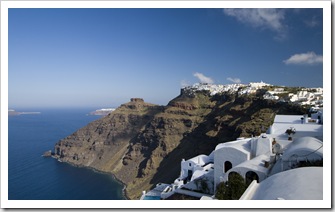 Santorini Island
Santorini IslandThe island of Santorini is an extremely picturesque place, the caldera rearing up out of the sea into 1000 foot cliffs overlooking three islands in and around the edge of the volcano. It has to be one of the most photographed of the Greek islands, the sugar-cube white houses lining the edge of the caldera and crystal clear deep blue water of the Aegean below. It is one of George Meis’ favorite islands on which to shoot his famous 360° panographs, reproductions of them are littered all over the islands and we’ve seen 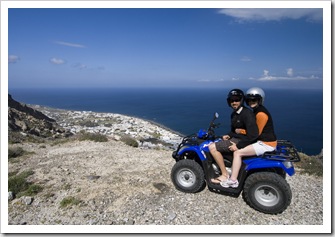 postcards of Santorini taken by Meis in every souvenir shop elsewhere in Greece. The island is the eastern portion of the caldera of an active volcano, the sugar-cube houses are connected by a maze of steep, cobbled walkways. As the island is volcanic there is very little dirt and thus the island is quite barren, there are no grazing animals, it’s a very stark landscape.
postcards of Santorini taken by Meis in every souvenir shop elsewhere in Greece. The island is the eastern portion of the caldera of an active volcano, the sugar-cube houses are connected by a maze of steep, cobbled walkways. As the island is volcanic there is very little dirt and thus the island is quite barren, there are no grazing animals, it’s a very stark landscape.
We rented a 100CC quad motorbike for the time we were in Santorini, it was a lot of fun to cruise around on and saved us waiting for the bus or paying for taxis. And for €10 a day it wasn’t a tough decision! During our six days on the island we pretty much saw it all, from the lighthouse at the island’s southern tip to Oia and Ammoudi in the north. The main town on the island is called Fira, which is 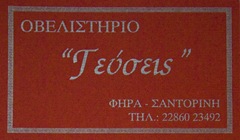 located in the center of the west coast and melds into Firostefani and Imerovigli to the north. Most of the restaurants are located in Fira with a few littered on the edge of
located in the center of the west coast and melds into Firostefani and Imerovigli to the north. Most of the restaurants are located in Fira with a few littered on the edge of 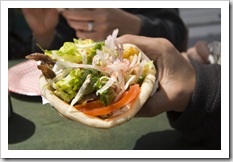 the caldera in Firostefani and Imerovigli between the plethora of hotels and apartment rentals. We were expecting Santorini to be very expensive as it exists almost exclusively as a tourist destination, but were surprised that the food and accommodation was very similarly priced to the rest of Greece. We ate almost every lunch at probably one of the best gyros (yiros) shops in the world: Gefsis Souvlaki in the center of Fira (business card to the left). Gefsis serves up scrumptious pork, chicken and lamb wraps for between €2 and €2.50 each. By the end of our week on the island I think ET was at serious risk of turning into a gyros (yiros)! The food elsewhere was very good, so much to explore for such a small island. And so much to photograph…
the caldera in Firostefani and Imerovigli between the plethora of hotels and apartment rentals. We were expecting Santorini to be very expensive as it exists almost exclusively as a tourist destination, but were surprised that the food and accommodation was very similarly priced to the rest of Greece. We ate almost every lunch at probably one of the best gyros (yiros) shops in the world: Gefsis Souvlaki in the center of Fira (business card to the left). Gefsis serves up scrumptious pork, chicken and lamb wraps for between €2 and €2.50 each. By the end of our week on the island I think ET was at serious risk of turning into a gyros (yiros)! The food elsewhere was very good, so much to explore for such a small island. And so much to photograph…
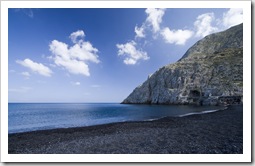 We spent three afternoons on Kamari Beach (N36°25.185’ E25°28.863’) during our week on the island. All of the beaches in Santorini are composed of black pebbles as opposed to sand due to the volcanic nature of the island. The days we were there it was around 30°C and the pebbles were almost too hot to walk on, I can imagine they get absolutely scalding in the heat of summer. Kamari is one of Santorini’s most popular beaches during summer, it stretches for a couple of kilometers and its western location protects it from the winds that often whip the towns on the eastern edge of the island. The southern end of the beach, where we spent our time, is located directly below Ancient Fira and is framed in by the limestone cliffs of Cape Mesa Vouno. ET, Tariq and I had some fun jumping off the cliffs with some of the local Greek schoolboys. I had my snorkeling gear with me, the visibility was amazing but unfortunately not too much to see under the surface except for a few schools of mullet.
We spent three afternoons on Kamari Beach (N36°25.185’ E25°28.863’) during our week on the island. All of the beaches in Santorini are composed of black pebbles as opposed to sand due to the volcanic nature of the island. The days we were there it was around 30°C and the pebbles were almost too hot to walk on, I can imagine they get absolutely scalding in the heat of summer. Kamari is one of Santorini’s most popular beaches during summer, it stretches for a couple of kilometers and its western location protects it from the winds that often whip the towns on the eastern edge of the island. The southern end of the beach, where we spent our time, is located directly below Ancient Fira and is framed in by the limestone cliffs of Cape Mesa Vouno. ET, Tariq and I had some fun jumping off the cliffs with some of the local Greek schoolboys. I had my snorkeling gear with me, the visibility was amazing but unfortunately not too much to see under the surface except for a few schools of mullet.
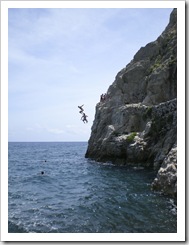
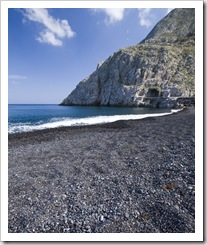
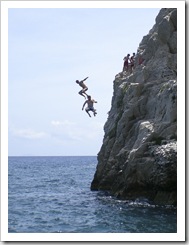 On our last day on the island we had a bit of wet weather so were forced to trade in our motorbikes for a little hatch back. The
On our last day on the island we had a bit of wet weather so were forced to trade in our motorbikes for a little hatch back. The 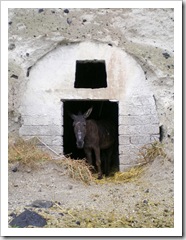 weather gave ET, Sally, Lisa and me a chance to explore the southern reaches of Santorini, the four of us visited the lighthouse at Cape Akrotiri as well as the town of Akrotiri and the Red Beach recommended to me by a mate of mine in San Francisco. The Red Beach would have been very cool to visit on a sunny day, the black beach is hemmed-in by bright red cliffs and the surrounding points looked great for some snorkeling. Maybe next time… We also explored Oia at the northern end of Santorini; a little ways from Fira, Oia came across as a lot less touristy and boasted some fantastic art galleries.
weather gave ET, Sally, Lisa and me a chance to explore the southern reaches of Santorini, the four of us visited the lighthouse at Cape Akrotiri as well as the town of Akrotiri and the Red Beach recommended to me by a mate of mine in San Francisco. The Red Beach would have been very cool to visit on a sunny day, the black beach is hemmed-in by bright red cliffs and the surrounding points looked great for some snorkeling. Maybe next time… We also explored Oia at the northern end of Santorini; a little ways from Fira, Oia came across as a lot less touristy and boasted some fantastic art galleries.
We both had a fantastic time in Santorini, such a picturesque location and so much fun sharing the week with a big group of friends. Corfu next to explore the island where Mum spent the summers teaching tourists to water-ski when she was in her twenties, then the sights of Athens and after that we head Down Under to Adelaide.
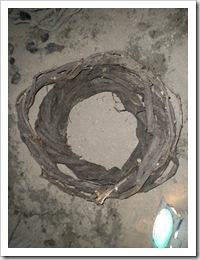
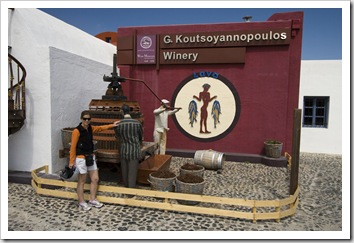 Santorini is one of the most well-known wine regions in all of Greece and home to the country’s only wine museum. While touring the island on our four-wheeler, we drove past the museum which was located at Koutsoyannopoulos Winery. The museum was very well done with an audio tour to accompany all of the displays. The Koutsoyannopoulos brother’s started the winery in 1660, growing grapes on Santorini was a challenge then and still looks to be hard work. All of the vines are grown, pruned and trained in circles so that the clusters ripen in the center of the circle and are protected by the high winds that often occur across the island. Early on donkeys were used to transport the grapes to the wineries and the entire family was involved in the harvest. It was said that this was one of the only times the daughters were let out of the house late at night, to work in the wineries. The women would run full-time kitchens at the winery and
Santorini is one of the most well-known wine regions in all of Greece and home to the country’s only wine museum. While touring the island on our four-wheeler, we drove past the museum which was located at Koutsoyannopoulos Winery. The museum was very well done with an audio tour to accompany all of the displays. The Koutsoyannopoulos brother’s started the winery in 1660, growing grapes on Santorini was a challenge then and still looks to be hard work. All of the vines are grown, pruned and trained in circles so that the clusters ripen in the center of the circle and are protected by the high winds that often occur across the island. Early on donkeys were used to transport the grapes to the wineries and the entire family was involved in the harvest. It was said that this was one of the only times the daughters were let out of the house late at night, to work in the wineries. The women would run full-time kitchens at the winery and 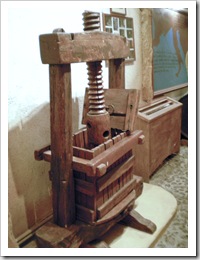 everyone would work around the clock until the task was complete. Since there are no trellised rows or defined vineyard blocks, white rocks are painted to mark where the grapes had already been picked so they could keep track of their progress. The Koutsoyannopoulos brothers seemed eager to improve and make their wine making process more efficient: they were the first to bring across basket-presses, filters and wood tanks from France. They also implemented electricity in the winery which sped up the process. I found it interesting that they used animal skins (only female) to transport the finished
everyone would work around the clock until the task was complete. Since there are no trellised rows or defined vineyard blocks, white rocks are painted to mark where the grapes had already been picked so they could keep track of their progress. The Koutsoyannopoulos brothers seemed eager to improve and make their wine making process more efficient: they were the first to bring across basket-presses, filters and wood tanks from France. They also implemented electricity in the winery which sped up the process. I found it interesting that they used animal skins (only female) to transport the finished 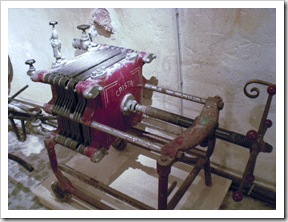 wine from one place to the next on the backs of donkeys. Apparently the female animal skin did not detract from the wine’s aromas as much as the male animal skins. The tour was very interesting and fun to see that things are definitely more automated now, but the process is pretty much the same. After the tour I tasted three wines at Koutsoyannopoulos Winery: Assyrtiko, Abelones, and Kamaritio. The Assyrtiko reminded me of a Sauvignon Blanc and is derived from the natural juice of the grape before it’s pressed which is called “anthos”. It is fresh and fruity, kept in stainless steel and bottled at five months. Abelones is made from only Santorinian varieties: Mantilaria, Mavrothiro, and Mavrotragano. The light red wine is aged in oak for one year and has a soft velvet aftertaste. I found it a bit thin and smoky but still enjoyable. Kamaritio is a sweeter style wine similar to the island’s well-known Vinsanto where the grapes are picked and laid out to dry in the vineyards, on roofs, or wherever they can find space. The result is rich spice, a tad sweet with a light mocha finish and a brilliant amber color.
wine from one place to the next on the backs of donkeys. Apparently the female animal skin did not detract from the wine’s aromas as much as the male animal skins. The tour was very interesting and fun to see that things are definitely more automated now, but the process is pretty much the same. After the tour I tasted three wines at Koutsoyannopoulos Winery: Assyrtiko, Abelones, and Kamaritio. The Assyrtiko reminded me of a Sauvignon Blanc and is derived from the natural juice of the grape before it’s pressed which is called “anthos”. It is fresh and fruity, kept in stainless steel and bottled at five months. Abelones is made from only Santorinian varieties: Mantilaria, Mavrothiro, and Mavrotragano. The light red wine is aged in oak for one year and has a soft velvet aftertaste. I found it a bit thin and smoky but still enjoyable. Kamaritio is a sweeter style wine similar to the island’s well-known Vinsanto where the grapes are picked and laid out to dry in the vineyards, on roofs, or wherever they can find space. The result is rich spice, a tad sweet with a light mocha finish and a brilliant amber color.
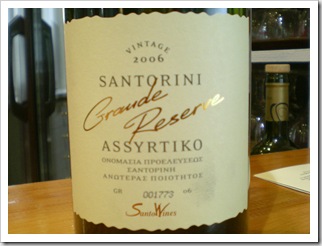 We then ventured across the island to the west-side and enjoyed a tasting at Santo Wines. The tasting room has an amazing view and we enjoyed tasting the wine accompanied with some cheese and olives. The winey is literally perched up on the edge of the caldera and looking out from the tasting room you can see the water on both the west and east sides of the island. We tasted a few wines and liked it so much that we went back with ET and Sally to enjoy a few more. The second line-up I tasted was their Assyrtiko Grand Reserve, Nykteri, Mavrotragano, Kameni, and a sip of Sally’s Imiglikos. The Assyrtiko was similar to that explained above except this particular one spent some time in oak. I found it interesting that they called it the English words “Grand Reserve” (which is one of Kendall-Jackson’s wines) when all of the other labels are in Greek. As a result of spending time in oak, the wine was less light and fruity and had more vanilla and apricot flavors but still had a mineral finish. Nykteri means “stay up all night” and is a blend of the varieties: Assyrtiko, Athiri, and Aidini. The wine is fermented in oak and had the aroma of lime leaves. Mavrotragano was a lighter style red wine with cherry aromas, this was my third favorite. The Kameni is the heaviest style red they make and definitely the heaviest that I have tried in all of Greece. It had dried fruit characters, a hint of olive and a subtle astringency. This was my favorite of all wines I tried in Greece. Lastly, the Imiglikos was a medium-sweet wine that reminded me of the juice in canned peaches.
We then ventured across the island to the west-side and enjoyed a tasting at Santo Wines. The tasting room has an amazing view and we enjoyed tasting the wine accompanied with some cheese and olives. The winey is literally perched up on the edge of the caldera and looking out from the tasting room you can see the water on both the west and east sides of the island. We tasted a few wines and liked it so much that we went back with ET and Sally to enjoy a few more. The second line-up I tasted was their Assyrtiko Grand Reserve, Nykteri, Mavrotragano, Kameni, and a sip of Sally’s Imiglikos. The Assyrtiko was similar to that explained above except this particular one spent some time in oak. I found it interesting that they called it the English words “Grand Reserve” (which is one of Kendall-Jackson’s wines) when all of the other labels are in Greek. As a result of spending time in oak, the wine was less light and fruity and had more vanilla and apricot flavors but still had a mineral finish. Nykteri means “stay up all night” and is a blend of the varieties: Assyrtiko, Athiri, and Aidini. The wine is fermented in oak and had the aroma of lime leaves. Mavrotragano was a lighter style red wine with cherry aromas, this was my third favorite. The Kameni is the heaviest style red they make and definitely the heaviest that I have tried in all of Greece. It had dried fruit characters, a hint of olive and a subtle astringency. This was my favorite of all wines I tried in Greece. Lastly, the Imiglikos was a medium-sweet wine that reminded me of the juice in canned peaches.
The Greek house wines were pretty good and very affordable. In most cafes or tavernas you can enjoy 0.5 liters of wine for €4-€5. At first I was a little intimidated about consuming an entire carafe myself, but the wines have much less alcohol than ours at home and it really wasn’t a problem to finish a carafe during a meal. We did try the popular Greek wine, Retsina, once and let’s just say once was enough!
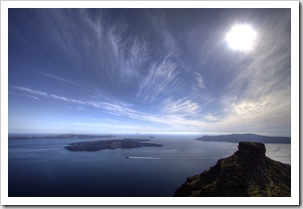
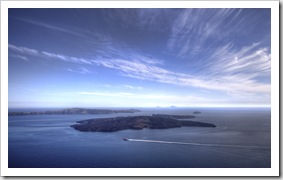 One of the main reasons for the portion of our trip that has taken us through Europe is Tariq and Andrea’s wedding in Santorini. They couldn’t have ordered better weather for the day, clear blue skies and not a hint of wind, a beautiful ceremony on the edge of the cliffs of Santorini. They stayed at Tholos Resort in the town of Imerovigli, one town north of where we stayed in Firostefani, and had the ceremony at their hotel. The wedding took place at sunset followed by a champagne toast, the ritual cake cutting and a fabulous dinner by the pool as the sun set. In attendance was: ET and Sally, Squino, Greg, Pete and Sarah, Lisa and myself from Australia; Tom from Canada; Tanya from Germany; and of course the bridge and groom. Here are a few shots from their big day (and I have to give ET credit for a few of them), we’re so glad we could share it with them!
One of the main reasons for the portion of our trip that has taken us through Europe is Tariq and Andrea’s wedding in Santorini. They couldn’t have ordered better weather for the day, clear blue skies and not a hint of wind, a beautiful ceremony on the edge of the cliffs of Santorini. They stayed at Tholos Resort in the town of Imerovigli, one town north of where we stayed in Firostefani, and had the ceremony at their hotel. The wedding took place at sunset followed by a champagne toast, the ritual cake cutting and a fabulous dinner by the pool as the sun set. In attendance was: ET and Sally, Squino, Greg, Pete and Sarah, Lisa and myself from Australia; Tom from Canada; Tanya from Germany; and of course the bridge and groom. Here are a few shots from their big day (and I have to give ET credit for a few of them), we’re so glad we could share it with them!
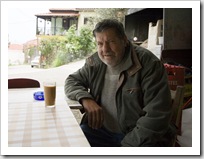
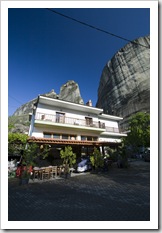
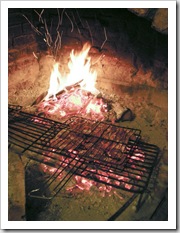 Definitely one of the best places we’ve visited so far, Kalambaka is a small mountain town nestled amongst surrounding granite monoliths. The surrounding peaks are home to a collection of orthodox monasteries, the way they are perched atop the rocks is an amazing sight. One of the monasteries, Moni Agios Triados, was the venue for the James Bond film For Your Eyes Only.
Definitely one of the best places we’ve visited so far, Kalambaka is a small mountain town nestled amongst surrounding granite monoliths. The surrounding peaks are home to a collection of orthodox monasteries, the way they are perched atop the rocks is an amazing sight. One of the monasteries, Moni Agios Triados, was the venue for the James Bond film For Your Eyes Only.
We arrived in Kalambaka on a late train from Thessaloniki and trudged up into the mountains through town laden with our packs. Koka Roka Taverna, our home for the two nights we were in Kalambaka, is owned by Katerina and Nick who run the place along with their son Arthur. Nick was born in Kalambaka and Katerina a town nearby, they both moved to Melbourne many years ago and returned to Kalambaka with Arthur when we was 12 to start Koka Roka. Koka Roka was fantastic, we enjoyed our dinner 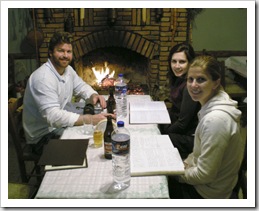 so much the first night that we ate there on our second evening as
so much the first night that we ate there on our second evening as 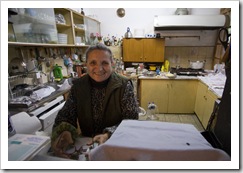 well. All the meat is cooked over an open flame, we’d sit there enjoying our tzatziki while our dinners cooked, at the same time knocking back a few Amstels and some homemade wine. Nick is quite happy to sit on his table out the front of the taverna all day and evening (he’s pictured doing so above), consuming either coffee or beer along with his Marlboros. Katerina and Arthur seem to handle the main operation of Koka Roka and do a fantastic job, the rooms were some of the cleanest we’d had throughout Turkey and Greece (although it was a bit of a challenge to battle Sally for the hot water whilst we both happened to have our showers at the same time!). ET and I sampled Nick’s homemade Ouzo after hiking through the monasteries, I don’t think I’ve ever seen ET wince as a result of alcohol quite as much as he did when he knocked his back, it was sure hot on the way down. After we’d drunk the ouzo Nick enjoyed showing us how well it holds a flame by dipping a cotton bud in it and setting it alight!
well. All the meat is cooked over an open flame, we’d sit there enjoying our tzatziki while our dinners cooked, at the same time knocking back a few Amstels and some homemade wine. Nick is quite happy to sit on his table out the front of the taverna all day and evening (he’s pictured doing so above), consuming either coffee or beer along with his Marlboros. Katerina and Arthur seem to handle the main operation of Koka Roka and do a fantastic job, the rooms were some of the cleanest we’d had throughout Turkey and Greece (although it was a bit of a challenge to battle Sally for the hot water whilst we both happened to have our showers at the same time!). ET and I sampled Nick’s homemade Ouzo after hiking through the monasteries, I don’t think I’ve ever seen ET wince as a result of alcohol quite as much as he did when he knocked his back, it was sure hot on the way down. After we’d drunk the ouzo Nick enjoyed showing us how well it holds a flame by dipping a cotton bud in it and setting it alight!
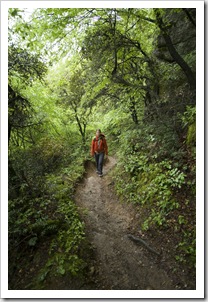
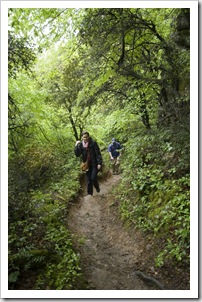
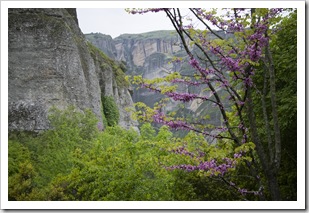 Our day in Meteora was devoted to exploring the monasteries of the area. The seven monasteries of Meteora are all perched precariously atop giant granite monoliths, it boggles the mind to think how they were constructed centuries ago. Up until about 10 years ago the road connecting the monasteries was a dirt track, and most of the monasteries have only had paths leading up to them for 30-40 years. Prior to that the only means of connecting each monastery to the outside world was via a winch and cradle (pictured here a couple of times) that transported people, goods and food the hundreds of feet to the valley floors. Koka Roka is situated at the very top of the town of Kalambaka at the beginning of the hiking trail connecting town to the first of the monasteries we visited, Moni Agios Triados (the one from For
Our day in Meteora was devoted to exploring the monasteries of the area. The seven monasteries of Meteora are all perched precariously atop giant granite monoliths, it boggles the mind to think how they were constructed centuries ago. Up until about 10 years ago the road connecting the monasteries was a dirt track, and most of the monasteries have only had paths leading up to them for 30-40 years. Prior to that the only means of connecting each monastery to the outside world was via a winch and cradle (pictured here a couple of times) that transported people, goods and food the hundreds of feet to the valley floors. Koka Roka is situated at the very top of the town of Kalambaka at the beginning of the hiking trail connecting town to the first of the monasteries we visited, Moni Agios Triados (the one from For 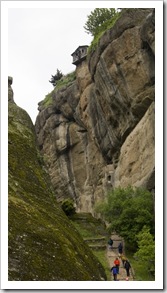 Your Eyes Only) (N39°42.799’ E21°38.196’). It was misting rain during our hike up, but it’d stopped
Your Eyes Only) (N39°42.799’ E21°38.196’). It was misting rain during our hike up, but it’d stopped 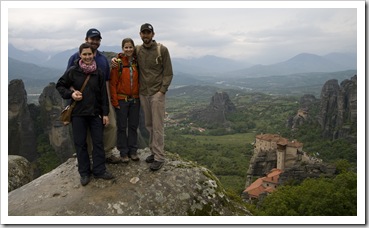 by the time we reached the monastery. Agios Triados, as with all the other monasteries in Meteora, incorporates a winch and cradle, various prayer rooms, and a small two-roomed chapel. Iconography completely covers the walls from floor to domed ceiling of each of the chapels, the intricacy and realism of the images was amazing. We ran into a couple of Aussie Greek Orthodox lads from Melbourne on a pilgrimage through Israel and the monasteries of Meteora who filled us in on the history and meaning behind some of the iconographs, it was great to get some inside knowledge from people who had studied the Meteora sites from a very young age. Evidently, at the time when many of the Greek monasteries were constructed illiteracy was extremely high so iconographs were used in place of script to convey the gospel. The Aussie brothers also clued us in on the caves we saw in a number of the monoliths: the caves are actually hermitages used by monks (to this day) who are studying to be conveyed the full priesthood, monks can be sent to the hermitages for lengths of time ranging from one week to 50 years until the elders decide they are on the correct spiritual path!
by the time we reached the monastery. Agios Triados, as with all the other monasteries in Meteora, incorporates a winch and cradle, various prayer rooms, and a small two-roomed chapel. Iconography completely covers the walls from floor to domed ceiling of each of the chapels, the intricacy and realism of the images was amazing. We ran into a couple of Aussie Greek Orthodox lads from Melbourne on a pilgrimage through Israel and the monasteries of Meteora who filled us in on the history and meaning behind some of the iconographs, it was great to get some inside knowledge from people who had studied the Meteora sites from a very young age. Evidently, at the time when many of the Greek monasteries were constructed illiteracy was extremely high so iconographs were used in place of script to convey the gospel. The Aussie brothers also clued us in on the caves we saw in a number of the monoliths: the caves are actually hermitages used by monks (to this day) who are studying to be conveyed the full priesthood, monks can be sent to the hermitages for lengths of time ranging from one week to 50 years until the elders decide they are on the correct spiritual path!
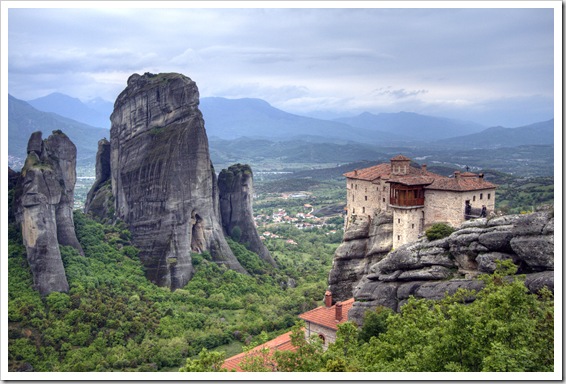 From Moni Agios Triados we followed the road to Moni Varlaam (N39°43.556’ E21°37.851’) and Moni Megalou Meteorou (N39°43.595’ E21°37.646’). Unfortunately Megalou Meteorou was closed for the day when we visited (each monastery is closed for one day per week), Megalou Meteorou is the largest of all the monasteries due to the fact that a Serbian emperor once donated his entire wealth to the monastery and became a monk! We were still able to see the structure from the outside, however, and what a sight to behold. After Varlaam and Megalou Meteorou we started to make our way down to Moni Agias Varvaras Rousanou (N39°43.299’ E21°37.925’), which is inhabited by nuns instead of monks and the four of us agreed was probably the prettiest of the monasteries we visited. The grounds were covered with potted flowers and beautiful ferns, Sally and Lisa were sure we noted the feminine touch. Last on the trip was Moni Agiou Nikolaou Anapafsa (N39°43.418’ E21°37.489’) which is almost in the village of Kastraki. A few kilometers around the granite monoliths behind Kalambaka took us back to town, where we enjoyed a fantastic afternoon snack of tzatziki and melitzanosalata as well as enough fried zucchini to sink a ship (we ordered three servings and could have done with one!).
From Moni Agios Triados we followed the road to Moni Varlaam (N39°43.556’ E21°37.851’) and Moni Megalou Meteorou (N39°43.595’ E21°37.646’). Unfortunately Megalou Meteorou was closed for the day when we visited (each monastery is closed for one day per week), Megalou Meteorou is the largest of all the monasteries due to the fact that a Serbian emperor once donated his entire wealth to the monastery and became a monk! We were still able to see the structure from the outside, however, and what a sight to behold. After Varlaam and Megalou Meteorou we started to make our way down to Moni Agias Varvaras Rousanou (N39°43.299’ E21°37.925’), which is inhabited by nuns instead of monks and the four of us agreed was probably the prettiest of the monasteries we visited. The grounds were covered with potted flowers and beautiful ferns, Sally and Lisa were sure we noted the feminine touch. Last on the trip was Moni Agiou Nikolaou Anapafsa (N39°43.418’ E21°37.489’) which is almost in the village of Kastraki. A few kilometers around the granite monoliths behind Kalambaka took us back to town, where we enjoyed a fantastic afternoon snack of tzatziki and melitzanosalata as well as enough fried zucchini to sink a ship (we ordered three servings and could have done with one!).
Kalambaka and Meteora are probably the highlight of our trip so far, there aren’t many places in the world I’ve visited that make me stand back and stare at the landscape in awe. The fact that we drank our fill of €1.50 500mL beers and ate scrumptious Greek food cooked over an open flame was icing on the cake!

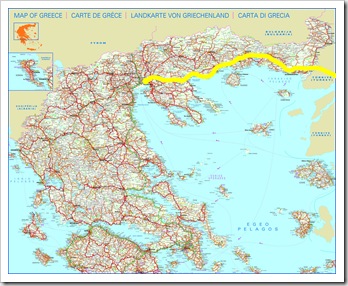
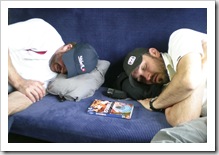 Whew, what a ride we had to get to Thessaloniki! We caught an 8:30AM train from Sirkeci Station in Istanbul to the border town of Edirne. In Edirne a Turkish police officer came through the train and collected everyone’s passports (we weren’t too keen on him taking our passports in the middle of nowhere, to say the least!). About 15 minutes later they were returned to us and the train proceeded to the Greek side of the border where we were left on the side of the tracks (literally) for around two hours to wait for the Greek train to Thessaloniki. The 14-hour train ride made for a fairly long day, we managed to sleep here and there on the way, but neither the Turkish or Greek trains had food available so we were quite famished when we pulled into Thessaloniki at 10:50PM. ET wasn’t going to bed until he’d feasted on a gyros (yiros) so at midnight we went trolling the streets of Thessaloniki for some meat on a spit! We found a great gyros (yiros) shop called Bapdapas and it didn’t disappoint.
Whew, what a ride we had to get to Thessaloniki! We caught an 8:30AM train from Sirkeci Station in Istanbul to the border town of Edirne. In Edirne a Turkish police officer came through the train and collected everyone’s passports (we weren’t too keen on him taking our passports in the middle of nowhere, to say the least!). About 15 minutes later they were returned to us and the train proceeded to the Greek side of the border where we were left on the side of the tracks (literally) for around two hours to wait for the Greek train to Thessaloniki. The 14-hour train ride made for a fairly long day, we managed to sleep here and there on the way, but neither the Turkish or Greek trains had food available so we were quite famished when we pulled into Thessaloniki at 10:50PM. ET wasn’t going to bed until he’d feasted on a gyros (yiros) so at midnight we went trolling the streets of Thessaloniki for some meat on a spit! We found a great gyros (yiros) shop called Bapdapas and it didn’t disappoint.
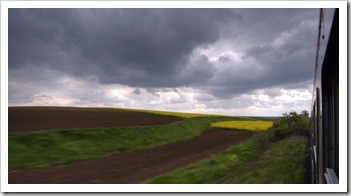 We stopped off at a few of the local tourist spots during our day in Thessaloniki, basically spending the day doing a walking tour of the city. We visited the Church of Agios Dimitrios, purportedly the holiest church in Greece, as well as the crypt underneath the church where the saint was martyred. The crypt was originally a Roman bath, but after Saint Dimitrios was executed for practicing Christianity the church was built on top of the baths in the eighth century and the baths turned into a crypt. The crypt was a great spot, a maze of underground rooms that are maintained very well by the church. ET also discovered that the house in which Ataturk was born (the founder of modern-day Turkey) is located in downtown Thessaloniki; after seeing Ataturk’s statue plastered all over Turkey and witnessing the Turks’ reverence for him during our time in Turkey it was interesting to see his birthplace. We spent the afternoon strolling the waterfront of Thessaloniki, starting at the famous White Tower and making a circle back past the Church of Agios Dimitrios then to our hotel for the late train to Kalambaka.
We stopped off at a few of the local tourist spots during our day in Thessaloniki, basically spending the day doing a walking tour of the city. We visited the Church of Agios Dimitrios, purportedly the holiest church in Greece, as well as the crypt underneath the church where the saint was martyred. The crypt was originally a Roman bath, but after Saint Dimitrios was executed for practicing Christianity the church was built on top of the baths in the eighth century and the baths turned into a crypt. The crypt was a great spot, a maze of underground rooms that are maintained very well by the church. ET also discovered that the house in which Ataturk was born (the founder of modern-day Turkey) is located in downtown Thessaloniki; after seeing Ataturk’s statue plastered all over Turkey and witnessing the Turks’ reverence for him during our time in Turkey it was interesting to see his birthplace. We spent the afternoon strolling the waterfront of Thessaloniki, starting at the famous White Tower and making a circle back past the Church of Agios Dimitrios then to our hotel for the late train to Kalambaka.
A packed train ride from Selcuk to Izmir and then a quick flight on Turkish Airlines brought us back to Istanbul where we spent three nights exploring the wonders of the historic city. We had a couple of days to ourselves before meeting up with ET and Sally, who flew in from Glasgow on Tuesday night. What a great city, we could have spent more time in Istanbul, such a lively and hip place. We stayed right in the thick of the old town at Cem Sultan Hotel in-between the Blue Mosque and Aya Sofya, a couple of minutes walk from the light rail and about 15 minutes from the Grand Bazaar. More than a couple of days in one place enabled us to finally get some washing done! Definitely a bit of a temperature change further north away from the Mediterranean and Aegean, we even had a bit of rain whilst in the nation’s cultural capital.
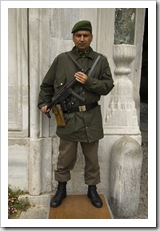 Topkapi Palace
Topkapi Palace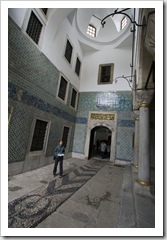
 Topkapi Palace is tucked in between the shores of the Bosphorous and the bustling tourist area of Sultanahmet in the center of Istanbul. The palace is surrounded by stone walls and beautiful gardens filled with tulips, it was built in 1453 by Mehmet the Conqueror and was inhabited by subsequent sultans until the 19th century. We spent around half a day in the palace and were glad we weren’t visiting during peak season as some of the exhibits involved 45-minute waits. Unfortunately photography was prohibited in the most extraordinary displays, but we still managed to get some good shots inside the harem and the rest of the palace grounds.
Topkapi Palace is tucked in between the shores of the Bosphorous and the bustling tourist area of Sultanahmet in the center of Istanbul. The palace is surrounded by stone walls and beautiful gardens filled with tulips, it was built in 1453 by Mehmet the Conqueror and was inhabited by subsequent sultans until the 19th century. We spent around half a day in the palace and were glad we weren’t visiting during peak season as some of the exhibits involved 45-minute waits. Unfortunately photography was prohibited in the most extraordinary displays, but we still managed to get some good shots inside the harem and the rest of the palace grounds.
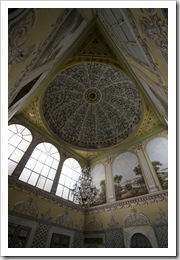
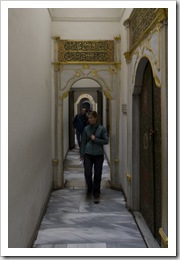
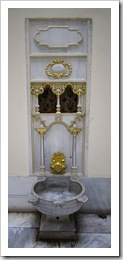 The first area we toured was the sultan’s harem, the section within the palace where all the sultan’s wives were kept (it does seem like the were kept, almost imprisoned) and tended to by a mass of eunuchs who devoted their lives to servitude. If I remember correctly, I think I overheard one tour guide mention that Sultan Ahmet had 112 children! The ornate woodwork and intricate tiling was amazing to see, it boggles the mind to think how long the artisans would have spent decorating the harem over 500 years ago.
The first area we toured was the sultan’s harem, the section within the palace where all the sultan’s wives were kept (it does seem like the were kept, almost imprisoned) and tended to by a mass of eunuchs who devoted their lives to servitude. If I remember correctly, I think I overheard one tour guide mention that Sultan Ahmet had 112 children! The ornate woodwork and intricate tiling was amazing to see, it boggles the mind to think how long the artisans would have spent decorating the harem over 500 years ago.
 The other noteworthy exhibits were the treasury, clothing display and the sacred safekeeping rooms in the palace’s third court. The treasury had the most breathtaking display of jewels I’ve ever seen, from egg-sized emeralds in the hilt of the Topkapi Dagger to the 86-carat
The other noteworthy exhibits were the treasury, clothing display and the sacred safekeeping rooms in the palace’s third court. The treasury had the most breathtaking display of jewels I’ve ever seen, from egg-sized emeralds in the hilt of the Topkapi Dagger to the 86-carat 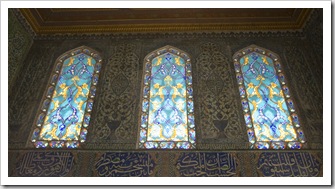 Spoonmaker’s Diamond (which is named as such because it was discovered in a rubbish dump during the reign of Mehmet IV and exchanged for three spoons!). The Spoonmaker’s Diamond is the world’s fifth largest diamond. Some of the most breathtaking items for
Spoonmaker’s Diamond (which is named as such because it was discovered in a rubbish dump during the reign of Mehmet IV and exchanged for three spoons!). The Spoonmaker’s Diamond is the world’s fifth largest diamond. Some of the most breathtaking items for 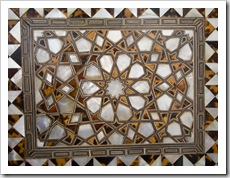 me were the diamond-encrusted stars donated to the sultans from foreign governments and monarchs, so brilliant they almost made me squint to look at them. The clothing exhibit had a display of original pieces from a range of sultans, the intricacy of the kaftans’ embroidery was amazing. My favorite was a 500+ year old fur-lined kaftan with its exterior made of white silk. The safekeeping rooms in the palace’s third court had quite a different crowd to the rest of the palace, the safekeeping rooms house an array of Muslim treasures from a number of different prophets. Muslims from all over the world undertake pilgrimages to view the religious treasures. We saw a lot of women in head-to-foot black gowns with only the tiniest of slits for their eyes, something we didn’t see anywhere else in Turkey. The safekeeping rooms have some amazing religious treasures, from actual pieces of the Prophet Muhammad’s beard and teeth to the millennia-old sword of the Prophet David.
me were the diamond-encrusted stars donated to the sultans from foreign governments and monarchs, so brilliant they almost made me squint to look at them. The clothing exhibit had a display of original pieces from a range of sultans, the intricacy of the kaftans’ embroidery was amazing. My favorite was a 500+ year old fur-lined kaftan with its exterior made of white silk. The safekeeping rooms in the palace’s third court had quite a different crowd to the rest of the palace, the safekeeping rooms house an array of Muslim treasures from a number of different prophets. Muslims from all over the world undertake pilgrimages to view the religious treasures. We saw a lot of women in head-to-foot black gowns with only the tiniest of slits for their eyes, something we didn’t see anywhere else in Turkey. The safekeeping rooms have some amazing religious treasures, from actual pieces of the Prophet Muhammad’s beard and teeth to the millennia-old sword of the Prophet David.
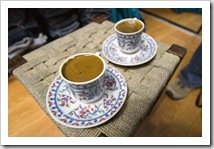
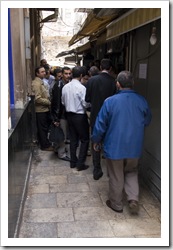
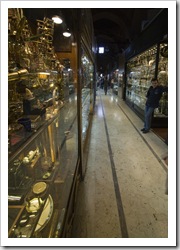 The Grand Bazaar and Spice Bazaar
The Grand Bazaar and Spice BazaarWe visited Istanbul’s two most famous bazaars on the first afternoon we were in Istanbul and happily revisited them both when Sally and ET arrived in town a couple of days later. The Grand Bazaar is a maze of anything and everything, from jeans to chess boards, Turkish carpets to cameras, I could have probably killed a day in the expansive shopping district. We sampled our first Turkish coffee in the 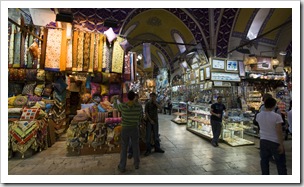 Grand Bazaar and both loved it, Lisa hadn’t drank coffee since 2001 so it was quite a leap for her. We were hooked after our first cup and had a quite a few more during our days in Istanbul. The Spice Bazaar was also a real treat, only a small portion of the size of the Grand Bazaar, as its name suggests the Spice Bazaar is almost exclusively devoted to spices and food. Most of the vendors offered some form of spices or dried fruit, while there were also a number of butchers offering mostly dried meats that would have made my dad salivate, as well as pastry shops and a few soap stands. I’m not usually a big fan of Turkish delight, but the sample I had in the Spice Bazaar had me immediately purchasing a few cubes of the treat, the tough part was choosing one of the more than 20 flavors on offer! Lots of photos here, but it such a picturesque location I just couldn’t help myself…
Grand Bazaar and both loved it, Lisa hadn’t drank coffee since 2001 so it was quite a leap for her. We were hooked after our first cup and had a quite a few more during our days in Istanbul. The Spice Bazaar was also a real treat, only a small portion of the size of the Grand Bazaar, as its name suggests the Spice Bazaar is almost exclusively devoted to spices and food. Most of the vendors offered some form of spices or dried fruit, while there were also a number of butchers offering mostly dried meats that would have made my dad salivate, as well as pastry shops and a few soap stands. I’m not usually a big fan of Turkish delight, but the sample I had in the Spice Bazaar had me immediately purchasing a few cubes of the treat, the tough part was choosing one of the more than 20 flavors on offer! Lots of photos here, but it such a picturesque location I just couldn’t help myself…
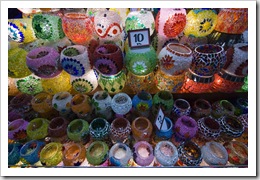
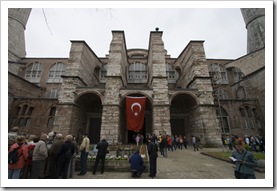 Aya Sofya and the Blue Mosque
Aya Sofya and the Blue MosqueWe visited both Aya Sofya and the Blue Mosque, arguably Istanbul’s two most famous landmarks, with ET and Sally on their first day with us in Istanbul. Both monuments are an amazing sight as they face each other across Sultanahmet Park, Aya Sofya originally a tribute to Christianity and the Blue Mosque a Muslim place of worship.
Aya Sofya was completed in 537 AD and was the greatest church in Christendom until the Conquest in 1453, when Mehmet the Conqueror converted the building to a mosque. The exterior of Aya Sofya is nowhere near as exquisite as that of the Blue Mosque, but the interior’s iconography was something to behold. The sheer size of the church was astounding, the interior has a cavernous feeling, the domed roof stretching hundreds of feet above the main hall’s floor. Quite interesting to see a building that was originally a church now with out-of-place Arabic scripts of Islam inserted into areas of prominence inside the structure. Today Aya Sofya is no longer used as a place of worship, it’s totally devoted to tourism as the adjacent Blue Mosque serves as the central place of worship in the Sultanahmet area.
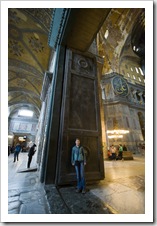
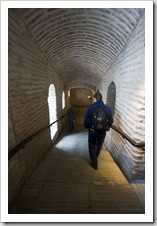
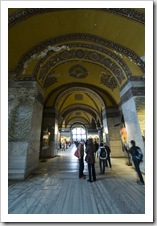
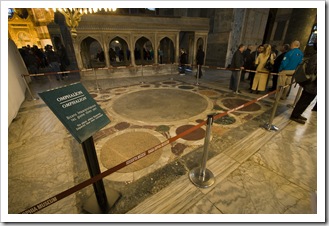 The Omphalion (pictured here to the right) is an area on the floor of the main hall of Aya Sofya that was designed to be the place at which emperors were coronated. Quite a feeling to stand there next to the stones on which countless emperors had knelt over the centuries to be coronated. So much history!
The Omphalion (pictured here to the right) is an area on the floor of the main hall of Aya Sofya that was designed to be the place at which emperors were coronated. Quite a feeling to stand there next to the stones on which countless emperors had knelt over the centuries to be coronated. So much history!
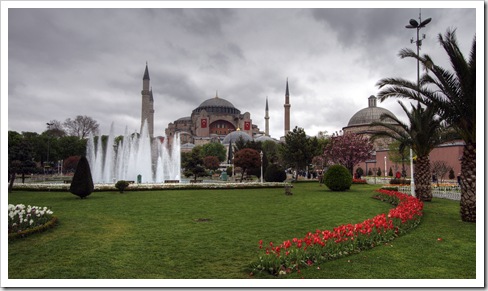 The Blue Mosque was constricted by Sultan Ahmet I in an attempt to surpass the beauty and elegance of Aya Sofya (that’s still Aya Sofya pictured to the left, but all the photos below are of the Blue Mosque). Contrary to the dedication of Aya Sofya, which was built as a place of worship for Christians, the Blue Mosque was constructed as a place of worship for the Islamic faith. On the exterior the mosque is a breathtaking structure to behold, it’s spires reach up toward the heavens with
The Blue Mosque was constricted by Sultan Ahmet I in an attempt to surpass the beauty and elegance of Aya Sofya (that’s still Aya Sofya pictured to the left, but all the photos below are of the Blue Mosque). Contrary to the dedication of Aya Sofya, which was built as a place of worship for Christians, the Blue Mosque was constructed as a place of worship for the Islamic faith. On the exterior the mosque is a breathtaking structure to behold, it’s spires reach up toward the heavens with 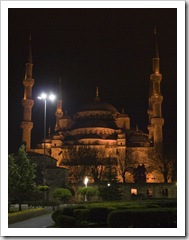 multiple domed roofs reflecting the sun. The blue tiles that give the mosque its name number in the tend of thousands, the central prayer space is enormous and is lit by hundreds of small windows. As the mosque is currently an active place of worship there are dress standards for those wishing to enter: females must wear a headscarf and both sexes must have long sleeves and pants or a skirt for women, also you can only wear socks, no shoes and no bare feet. There are also certain times of the day, namely prayer time, when the mosque is closed to visitors. While the interior of the Blue Mosque isn’t quite as intricately decorated as Aya Sofya it was still a sight to behold. It’s a little hard to make out here, but on each of the spires surrounding the mosque is an array of speakers from which the call to prayer is broadcast across Istanbul four or five times a day.
multiple domed roofs reflecting the sun. The blue tiles that give the mosque its name number in the tend of thousands, the central prayer space is enormous and is lit by hundreds of small windows. As the mosque is currently an active place of worship there are dress standards for those wishing to enter: females must wear a headscarf and both sexes must have long sleeves and pants or a skirt for women, also you can only wear socks, no shoes and no bare feet. There are also certain times of the day, namely prayer time, when the mosque is closed to visitors. While the interior of the Blue Mosque isn’t quite as intricately decorated as Aya Sofya it was still a sight to behold. It’s a little hard to make out here, but on each of the spires surrounding the mosque is an array of speakers from which the call to prayer is broadcast across Istanbul four or five times a day.
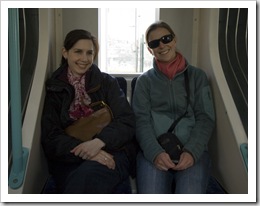 Istiklal Caddesi
Istiklal CaddesiBefore leaving San Francisco I sat down with a Turkish mate of mine, Kivanc Arda, and asked for the off-the-beaten-path locals-only areas of Istanbul we should visit to get a feel for what the city’s like away from the touristy areas. Istiklal Caddesi is the 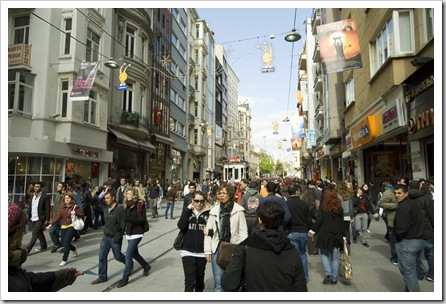 area that Kivanc said we had to visit. Istiklal Caddesi was a 30 minute train ride and then a quick jaunt in an underground funicular from our hotel Sultanahmet. The entire street, which runs for a few kilometers, is closed to traffic and is a huge open air mall. Lining the street was everything from hip Turkish clothes stores to NBA shops and the newest Diesel jeans. The first evening we ventured to Istiklal Caddesi it was raining and cold, but when we went back with Sally and ET the weather was perfect and the mall pumping with activity. One street off of the main drag near Istiklal’s center is an area called Nevizade which is a small alley crammed with seafood restaurants and bars. We were some of the very few non-Turks in the restaurants and bars during both of our visits, an excellent locale to kick back and have a few beers for the afternoon and then top it off with fantastic local food. We were fortunate to be sitting next to a table full of university students on one of our visits there, our waiter didn’t speak a lick of English and the students enjoyed helping us out with the menu translations. ET and I put back quite a few 500mL Efes lagers one afternoon in a few of Nevizade’s jaunts!
area that Kivanc said we had to visit. Istiklal Caddesi was a 30 minute train ride and then a quick jaunt in an underground funicular from our hotel Sultanahmet. The entire street, which runs for a few kilometers, is closed to traffic and is a huge open air mall. Lining the street was everything from hip Turkish clothes stores to NBA shops and the newest Diesel jeans. The first evening we ventured to Istiklal Caddesi it was raining and cold, but when we went back with Sally and ET the weather was perfect and the mall pumping with activity. One street off of the main drag near Istiklal’s center is an area called Nevizade which is a small alley crammed with seafood restaurants and bars. We were some of the very few non-Turks in the restaurants and bars during both of our visits, an excellent locale to kick back and have a few beers for the afternoon and then top it off with fantastic local food. We were fortunate to be sitting next to a table full of university students on one of our visits there, our waiter didn’t speak a lick of English and the students enjoyed helping us out with the menu translations. ET and I put back quite a few 500mL Efes lagers one afternoon in a few of Nevizade’s jaunts!
We say goodbye to Turkey after our time in Istanbul, off to Thessaloniki and then to Meteora before heading to Santorini for a wedding next weekend. We both loved Turkey, such a great time, the people were fantastic, food exquisite and a fabulous place to spend a few weeks exploring another culture. I could have spent a few more days in the sun in Fethiye and would love to go back and explore some more of the Lycian Way one day. Looking forward to Greece!
| S | M | T | W | T | F | S |
|---|---|---|---|---|---|---|
| 1 | 2 | 3 | 4 | 5 | 6 | |
| 7 | 8 | 9 | 10 | 11 | 12 | 13 |
| 14 | 15 | 16 | 17 | 18 | 19 | 20 |
| 21 | 22 | 23 | 24 | 25 | 26 | 27 |
| 28 | 29 | 30 | ||||